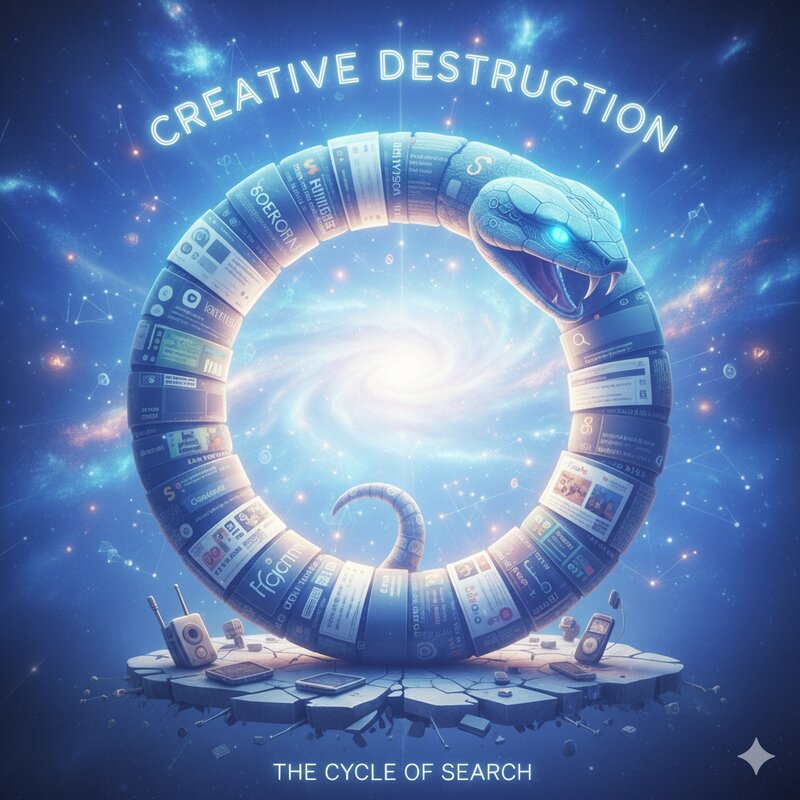Creative Destruction of Search Enshittification
Creative Destruction of Search Enshittification

The Cycle of Creative Destruction in Search
In the landscape of technology and economics, the term “Creative Destruction,” popularized by economist Joseph Schumpeter, aptly describes the relentless cycle of innovation and obsolescence that reshapes industries. This phenomenon is particularly evident in the realm of search engines, where notable transformations have mirrored Schumpeter’s theories since the early 2000s.
The Rise and Fall of Google: The Enshittification of Search
Google emerged as the unsurpassed leader in search in 2004, revolutionizing how users accessed information online. Its innovative algorithms catered to users’ needs, ensuring quick, relevant search results. However, as the platform evolved, the initial glory became tainted by what we now recognize as Enshittification. As Google prioritized personalized advertising, the platform began to degrade the user experience. What once was a free-flowing exchange of information turned into a heavily monetized environment, where the quality of search results diminished in favor of revenue generation. This degradation signifies a crucial aspect of Schumpeter’s theory—innovations can cannibalize their own success when they lose sight of their core value.
Enter OpenAI and the Promise of Differentiation
As Google faced these challenges, new players like OpenAI have entered the scene, heralding a new era of search capabilities driven by artificial intelligence. OpenAI markets its solutions with a promise of innovation, claiming to offer a distinctive approach that differs fundamentally from traditional search engines. However, as we delve deeper, it’s essential to scrutinize whether these claims truly reflect progressive advancement or if they merely represent a rebranding of existing technologies.
The Dual Nature of LLMs: Different Yet the Same
Large Language Models (LLMs) have emerged alongside these advancements, boasting capabilities that touch on the personalization of search experiences. While LLMs encourage a sense of novelty and intelligence in interactions, they, too, are subject to the principles of Enshittification if they focus excessively on advertising and monetization at the expense of user satisfaction. As these models gain traction, they present a paradox: are they genuinely different from their predecessors, or do they simply replicate past mistakes under a new guise?
The Final Reflection: A Future Uncertain
As we navigate this evolving landscape, it raises important questions about the future of search. Google stands at a crossroads, weighing whether to pivot toward its new innovations like Gemini while managing the legacy of its earlier successes. To remain relevant, Google may need to adopt a strategy akin to Apple’s, which famously cannibalized its iPod market to make way for the iPhone. By transitioning from a pure search model to something like Gemini, Google could rejuvenate its offerings and avoid the pitfalls of losing market share. The Enshittification that plagued its search platform cannot be redeemed.
OpenAI, now positioned as a significant contender, might reshape norms yet faces the challenge of sustaining its unique identity amidst fierce competition. Meanwhile, the fate of smaller challengers like Perplexity remains uncertain, as they grapple with establishing relevance in a marketplace dominated by giants.
Ultimately, the cycle of Creative Destruction continues unabated. For users, the emerging narrative is whether genuine choices will exist or if they will find themselves ensnared in a cycle of similarity disguised as innovation. The cycle of innovation, as Schumpeter suggested, ensures that while some models may fade, new iterations will consistently rise to take their place, echoing the fundamental truth of our evolving digital landscape.